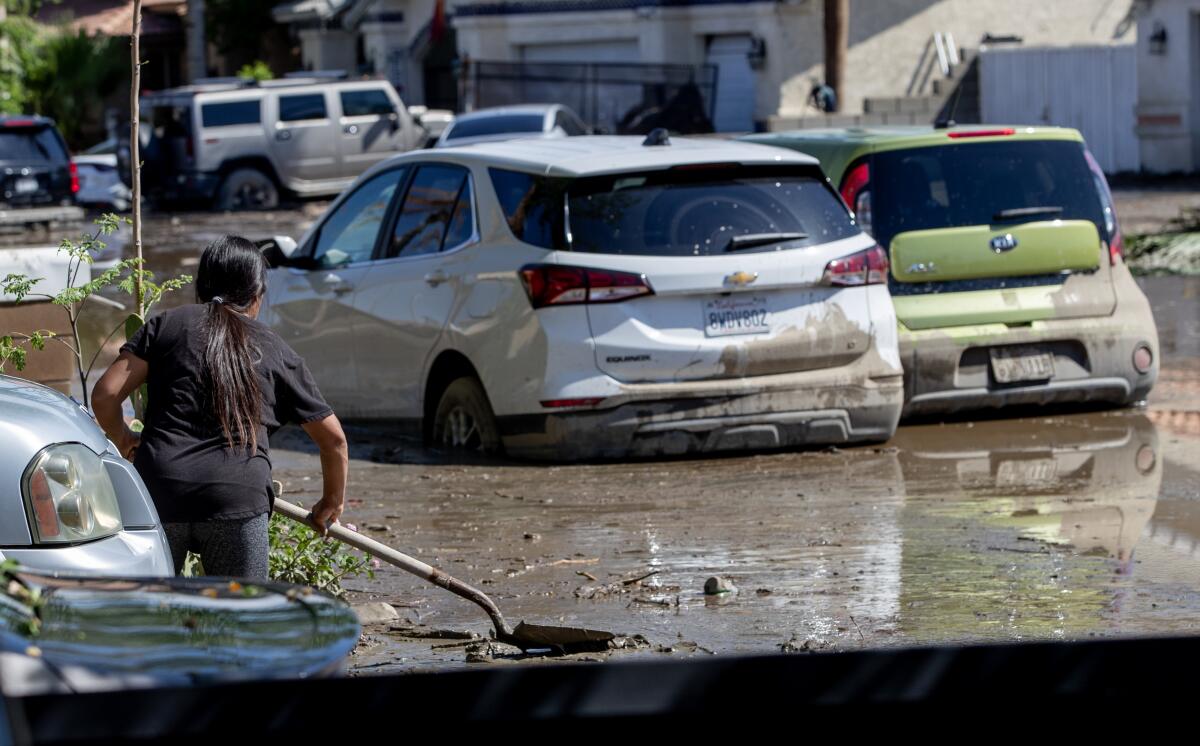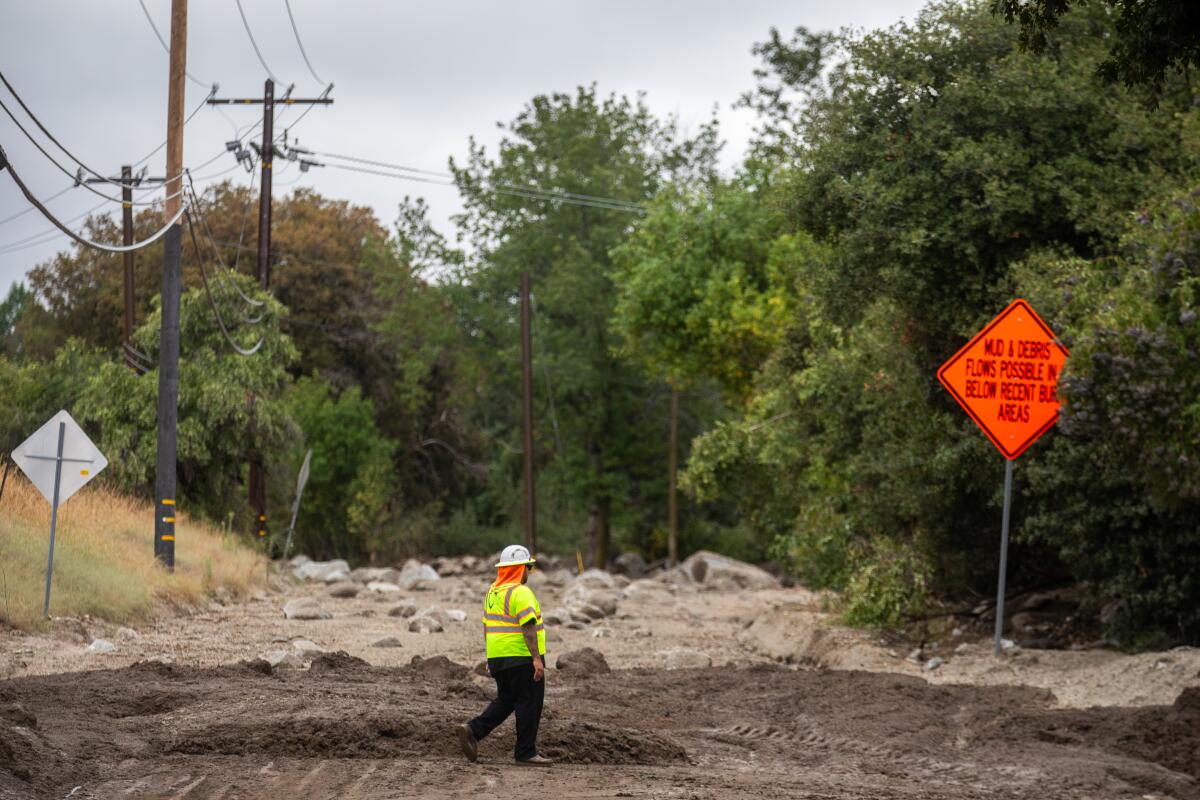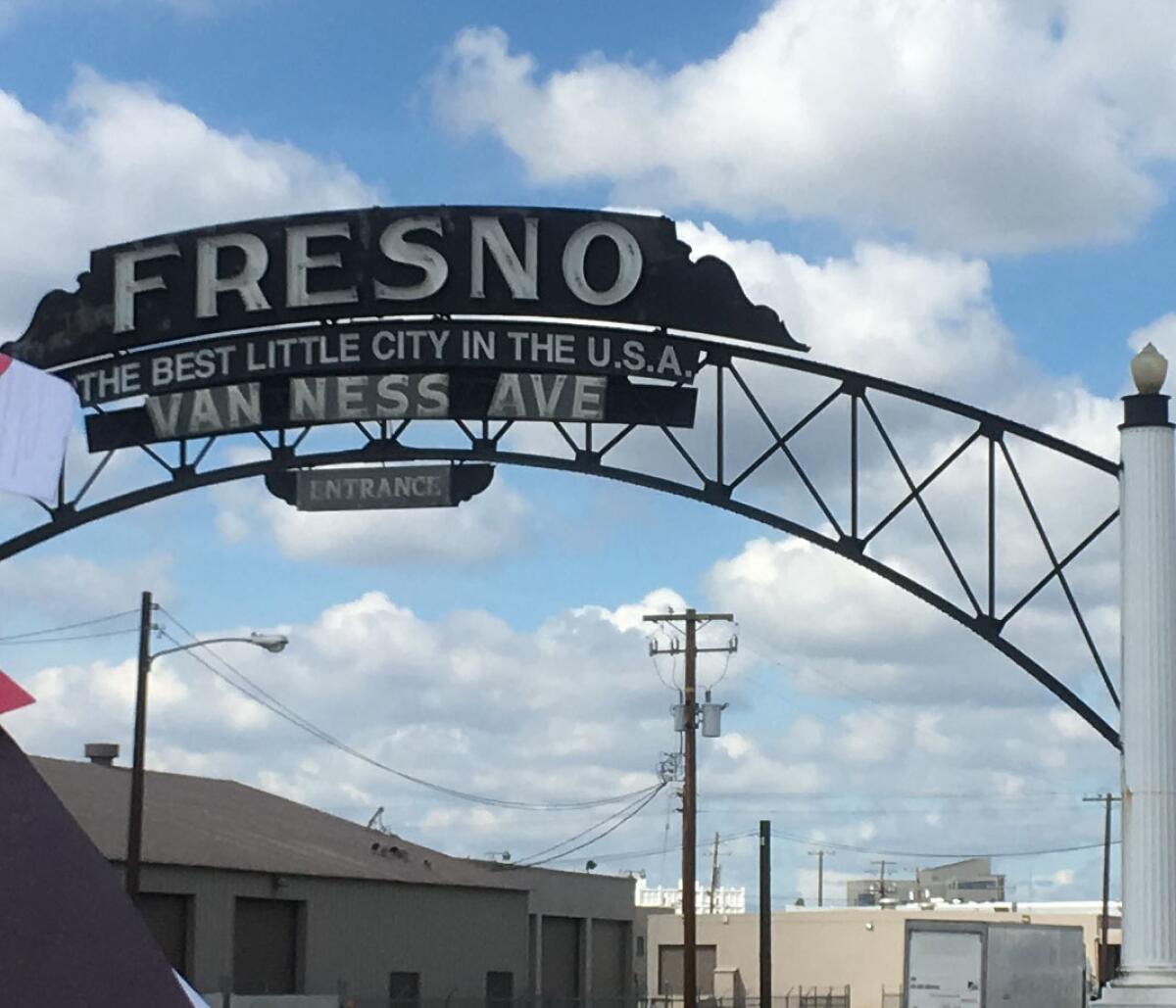How bad was Hilary? Mountain and desert communities got the worst of the tropical storm

- Share via
Good morning, and welcome to the Essential California newsletter. It’s Tuesday, Aug. 22.
The clouds parted over much of Southern California on Monday as residents, emergency responders and government officials began to assess just how hard Tropical Storm Hilary hit the region.
Aside from some downed power lines, toppled trees, damaged streets and clogged storm drains, Los Angeles and other major population centers made it through mostly unscathed. That led to some complaints about the storm being overhyped, mostly from people who probably didn’t follow the actual forecasts or understand that there’s a whole lot more SoCal east of the beaches and big cities.
“It will take days to determine the full scope of the damage to Southern California — and to understand why some areas were hit harder than others,” our colleagues Rong-Gong Lin II, Susanne Rust and Hannah Wiley wrote as they reported on the storm’s path.
With that in mind, here’s a look at what we know about Hilary’s major impacts and what some local weather and climate experts have to say about her spinning trip through the Southland.
Which areas were hit hardest — and why?
Communities in the typically dry Coachella Valley experienced a deluge of water that blocked roads and stranded cars.
Palm Springs received more than half its typical annual rainfall on Sunday, with nearly all of that coming down within six hours.
Mike Wofford, a meteorologist for the National Weather Service based in Oxnard, said Hilary’s trajectory created a “reverse situation” for desert regions where storms typically arrive from the west and have minimal impacts.
SoCal’s usual storm systems come in from the ocean and run up against the west side of our mountains. That dynamic “squeezes out all that moisture before it crosses over” into inland deserts, he said. But tropical storms like Hilary that swirl counterclockwise are different, pushing moisture up against the mountains from the east, Wofford explained:
“Not only did they have the rain falling on them, but they had the water coming down the mountain on top of that. They’re just not built to withstand that kind of condition.”
In Imperial County, flooding brought road closures and evacuation orders for communities around the Salton Sea, though those orders were lifted later Monday.
The storm also brought flooding and debris flows to parts of Kern and Inyo counties, closing roads and stranding vehicles in thick mud.
Most of Ventura County received less than an inch of rain, but a surprise came when a 5.1 magnitude earthquake complicated the day in Ojai. Businesses reported minor damage. Fire department officials evacuated three homes in Camarillo and conducted swift water rescues for three people in the Santa Clara River.
Some residents in San Bernardino and Riverside counties were stranded by debris flows and flash floods. In the mountain community of Forest Falls, San Bernardino County firefighters had to run to safety when a mudslide tore downhill, cutting off access to their fire station.
Many mountain roads were blocked by mudslides and San Bernardino National Forest officials closed many visitor centers and campsites Monday.
In San Diego, while thousands of utility customers did lose power for an hour, gas and electric officials said the outages were not as bad as they had anticipated. Placing power lines underground to prevent fires may have helped reduce power outages in the storm.
Across the border in Tijuana in Baja California, storm-related car crashes caused at least one death.
Was the storm as bad as expected?

This was an extremely rare weather event for California that churned through a wide, geographically diverse region. For those in basins and along the coast, it might feel like the storm’s impacts were overhyped. Twitter was awash in overdramatizations of the impacts to L.A. and San Diego, including some videos that real Angelenos will know were actually from the Universal Studios tram tour — but that fooled some journalists.
But for many residents living in and around regional mountains and in the high and low deserts to the east, Hilary was a major disruption.
Still, experts noted that the storm wasn’t as bad as it could have been in many parts of the Southland.
For one thing, the strong winds weren’t as widespread as expected. And in some western regions, the storm brought a decent amount of rain, but not enough to cause major problems.
“Even though the same amount of water fell overall in many cases, it didn’t fall as quickly as had been feared in some places,” Daniel Swain, a climate scientist at UCLA, said during a YouTube livestream Monday. “The flood impacts, thankfully, were not as catastrophic as they could have been.”
What’s next?
Should we expect tropical storms to be a more common occurrence in California’s future? We put that question to the NWS’ Wofford.
Though forecasters can’t make any broad predictions, he said, it’s possible we could get more storms like Hilary “given the atmospheric conditions” that warmed up the Pacific along California’s coast.
“These storms would weaken considerably much faster than this one did,” he said. “I think it’s reasonable to say that if we continue to see these kinds of warming patterns, [there is] probably a good chance that we’ll see additional storms over the coming decades and centuries.”
Here’s more coverage on formerly Tropical Storm Hilary from The Times:
- Hilary obliterated daily rainfall records. How much fell in your area?
- Trapped in Death Valley, hundreds wait for roads to be cleared
- A wall of mud and water brings destruction
- No, Dodger Stadium didn’t flood. That’s just a reflection
- School closures send parents scrambling
- Officials warn of unhealthy beach conditions
And now, here’s what’s happening across California:
Note: Some of the sites we link to may limit the number of stories you can access without subscribing.
L.A. STORIES
When Brittany Gorin first noticed a surcharge on her bill this year in April, she posted about her experiences on Reddit. Redditors since then have tracked the rise in dining fees across restaurants in Los Angeles in a spreadsheet. In an interview, Gorin talks about the importance of price transparency post-pandemic. LAist
During a “once-in-a-lifetime” weather event this weekend, Sam Masunaga shadowed Rose Schoenfeld. Meteorologist Schoenfeld works at the National Weather Service’s Oxnard office and prepares forecasts for mariners, pilots and airports and fields calls from media and the public. Read the latest addition to My LA Workday. Los Angeles Times
POLITICS, GOVERNMENT AND JUSTICE
As hip-hop welcomes its 50th anniversary, California’s current and past politicians reflect on how the music has influenced their careers. From police brutality to its application as court evidence and in AI, the music is still provoking discussions about high-stakes political issues. Los Angeles Times
Leaders from California’s largest state employee union say they’ve reached a tentative contract deal with Gov. Gavin Newsom’s administration. The not-yet-sealed agreement would give workers a 10% pay raise over the life of the three-year contract, though union negotiators had initially proposed a 30% increase over that period. Sacramento Bee
Former justices on California’s Supreme Court are worried about the increasing divide between national and state views on religion. The constitutional separation of church and state has become “very fragile,” said Kathryn Mickle Werdegar, who retired from the California court in 2017. These thoughts come after the U.S. Supreme Court’s rulings regarding the refusal of service to LGBTQ+ customers and a football coach’s role in leading prayers at a high school, among many others. San Francisco Chronicle
A pride flag, an argument and gunfire: The senseless killing of Laura Ann Carleton. In Lake Arrowhead, Laura Ann Carleton flew a pride flag from the outside of her clothing shop, Mag.Pi. Last Friday, she was shot and killed by a man who first made “several disparaging remarks about a rainbow flag that stood outside the store.” Days later, the violence of Carleton’s killing — and the outpouring of support from residents, friends and supporters of the LGBTQ+ community — still cling to the scene of the crime. Los Angeles Times
Support our journalism
HEALTH AND THE ENVIRONMENT
Five years after the Camp fire devastated Paradise in the deadliest wildfire in California history, survivors look toward Lahaina’s fires with caution. “When I saw Maui, it just took me back,” said Joshua Stokes. He and many other residents are living in trailers or campers on their own land while they wait for settlement money from PG&E to build. Los Angeles Times
CALIFORNIA CULTURE
For years, Merritt College drew students to its doors. Then it moved out of North Oakland. Robin Buller looks at the history of this community college and its role in developing young activists such as the co-founders of the Black Panther movement. Its move has shifted the college’s demographics and culture of North Oakland. San Francisco Chronicle
Jennifer Cohen becomes USC’s newest athletic director. After eight years at the University of Washington, Cohen joins the USC staff as the first woman to hold the position of athletic director in the school’s history. She takes over a department that has been without a leader for three months after the former director stepped down amid mismanagement and misconduct allegations. Los Angeles Times
Free online games
Get our free daily crossword puzzle, sudoku, word search and arcade games in our new game center at latimes.com/games.
AND FINALLY
Today’s California landmark is from Fresno resident Dennis Cordell, who shared this prominent sign in his hometown.

Dennis writes:
Every time I pass this sign I feel proud to be a Fresnian living in the great state of California.
What are California’s essential landmarks? Fill out this form to send us your photos of a special spot in California — natural or human-made. Tell us why it’s interesting and what makes it a symbol of life in the Golden State. Please be sure to include only photos taken directly by you. Your submission could be featured in a future edition of the newsletter.
Please let us know what we can do to make this newsletter more useful to you. Send comments to essentialcalifornia@latimes.com.
Sign up for Essential California
The most important California stories and recommendations in your inbox every morning.
You may occasionally receive promotional content from the Los Angeles Times.








